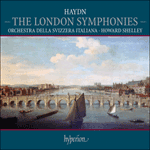
Welcome to Hyperion Records, a British classical label devoted to presenting high-quality recordings of music of all styles and from all periods from the twelfth century to the twenty-first.
Hyperion offers both CDs, and downloads in a number of formats. The site is also available in several languages.
Please use the dropdown buttons to set your preferred options, or use the checkbox to accept the defaults.

| Orchestra della Svizzera Italiana, Howard Shelley (conductor)» More |
After a lilting theme-and-variations Andante in E flat that includes an expressive cello solo and a free minore episode, the minuet again juxtaposes C minor and major. The main section is by turns edgy and aggressive, while the untroubled C major trio features another, more extended, solo for cello. With the many solo passages, here and elsewhere in the first six London symphonies, Haydn endeared himself both to his audience and his orchestral principals. The sonata-rondo finale begins with a broad, serene C major melody, which Haydn then proceeds to work in an intricate display of counterpoint. With its polyphonic virtuosity and pealing C major splendour (darkened fleetingly by a stormy C minor outburst), the movement has provoked inevitable comparisons with Mozart’s ‘Jupiter’ Symphony. Haydn may even have consciously modelled his far terser finale on Mozart’s.
from notes by Richard Wigmore © 2009
Après un allant thème-et-variations Andante en mi bémol incluant un expressif solo de violoncelle et un épisode minore libre, le menuet juxtapose une nouvelle fois ut mineur et majeur. La section principale est tour à tour nerveuse et agressive, tandis que le tranquille trio en ut majeur met en scène un autre solo violoncellistique, plus étendu. Avec les nombreux passages solo disséminés dans ses six premières symphonies londoniennes, Haydn se fit aimer et de son public et de ses chefs de pupitre. Le finale en rondo-sonate s’ouvre sur une large et sereine mélodie en ut majeur, qui est ensuite travaillée dans une complexe démonstration de contrepoint. Avec sa virtuosité polyphonique et sa retentissante splendeur en ut majeur (fugacement assombries par une tempétueuse explosion en ut mineur), le mouvement a suscité d’inévitables comparaisons avec la Symphonie «Jupiter» de Mozart. Peut-être même Haydn a-t-il sciemment modelé son finale, bien plus laconique, sur celui de Mozart.
extrait des notes rédigées par Richard Wigmore © 2009
Français: Hypérion
Nach einem Andante in Es-Dur, einem beschwingten Thema und Variationen, das ein expressives Cellosolo und eine freie Minore-Episode enthält, stellt das Menuett wiederum c-Moll und C-Dur gegenüber. Der Hauptteil ist abwechselnd nervös und aggressiv, während das sorglose C-Dur-Trio ein weiteres ausgedehnteres Solo für Cello enthält. Mit den vielen Solopassagen hier und in den anderen ersten sechs Londoner Symphonien machte sich Haydn sowohl beim Publikum und seinen Stimmführern im Orchester beliebt. Das Sonatenrondo-Finale beginnt mit einer breiten, heiteren C-Dur-Melodie, die Haydn dann in einem komplizierten kontrapunktischen Display verarbeitet. Mit seiner polyphonen Virtuosität und schallenden C-Dur-Glanz (der kurz von einem stürmischen c-Moll-Ausbruch verdunkelt wird) hat dieser Satz unvermeidbar Vergleiche mit Mozart „Jupiter“-Symphonie hervorgerufen. Haydn könnte sein wesentlich strafferes Finale sogar bewusst nach Mozarts Vorbild geschaffen haben.
aus dem Begleittext von Richard Wigmore © 2009
Deutsch: Renate Wendel
 Haydn: The London Symphonies Haydn: The London SymphoniesIn 2009, the music world will commemorate the 200th anniversary of the death of Joseph Haydn. On Hyperion, Howard Shelley and his stylish Continental orchestra present the symphonies that made Haydn the most famous and popular composer alive in the 1 ...» More |

